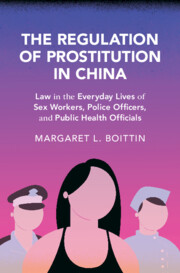 The Regulation of Prostitution in China
The Regulation of Prostitution in China Book contents
- The Regulation of Prostitution in China
- Cambridge Studies in Law and Society
- The Regulation of Prostitution in China
- Copyright page
- Dedication
- Contents
- Acknowledgments
- 1 Introduction
- Part I History, Contemporary Context, and Official Policies
- Part II Society
- 4 On the Streets and in the Brothels
- 5 In the Clubs
- 6 In the Home
- 7 Perspectives and Experiences Shared across Tiers of Prostitution
- Part III The State
- Book part
- Bibliography
- Index
- Cambridge Studies in Law and Society
7 - Perspectives and Experiences Shared across Tiers of Prostitution
from Part II - Society
Published online by Cambridge University Press: 05 December 2024
- The Regulation of Prostitution in China
- Cambridge Studies in Law and Society
- The Regulation of Prostitution in China
- Copyright page
- Dedication
- Contents
- Acknowledgments
- 1 Introduction
- Part I History, Contemporary Context, and Official Policies
- Part II Society
- 4 On the Streets and in the Brothels
- 5 In the Clubs
- 6 In the Home
- 7 Perspectives and Experiences Shared across Tiers of Prostitution
- Part III The State
- Book part
- Bibliography
- Index
- Cambridge Studies in Law and Society
Summary
This chapter is about the perspectives and experiences that female sex workers in China share across tiers of prostitution. The daily lives of low-tier sex workers, hostesses, and second wives in China differ from each other in important ways. Yet despite relatively fixed boundaries between tiers of prostitution, these women do not exist in unrelated, independent silos. After all, their source of income comes from the same activity: exchanging sex for money or other material goods. The chapter first highlights how movement across tiers of sex work is limited, and how low-tier sex workers and hostesses express a preference for the work conditions in their own tier, rather than voice a desire to move up in the pecking order. It then examines narratives that these women have in common across all three tiers. Lastly, it discusses how sex workers who cross paths with grassroots organizations develop a shared consciousness of their membership in a global community of sex work civil society, and appropriate its language and symbols in their own lives.
- Type
- Chapter
- Information
- The Regulation of Prostitution in ChinaLaw in the Everyday Lives of Sex Workers, Police Officers, and Public Health Officials, pp. 167 - 204Publisher: Cambridge University PressPrint publication year: 2024
